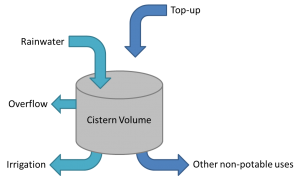Difference between revisions of "Rainwater harvesting: Sizing and modeling"
Jump to navigation
Jump to search
Jenny Hill (talk | contribs) |
Jenny Hill (talk | contribs) (→Rapid) |
||
| Line 1: | Line 1: | ||
| − | === | + | <html> |
| − | + | <head> | |
| + | <body> | ||
| + | <img src = "http://mediawiki.trca.info/images/thumb/9/9d/Cistern_Size.png/800px-Cistern_Size.png" alt="schematic diagram shows rainwater and top-up as inputs to rainwater harvesting cistern, and outputs are irrigation, other non-potable uses, and overflow" width = 200> | ||
| + | </body> | ||
| + | </html> | ||
| + | [[file:Cistern_Size.png | thumb |Caption]] | ||
| + | <h4>Rapid</h4> | ||
| + | Cistern size can be estimated by multiplying the depth | ||
===Interactive Sizing Tool=== | ===Interactive Sizing Tool=== | ||
Revision as of 19:08, 2 June 2017
<html>
<head>
<body>
<img src = " " alt="schematic diagram shows rainwater and top-up as inputs to rainwater harvesting cistern, and outputs are irrigation, other non-potable uses, and overflow" width = 200>
</body>
</html>
" alt="schematic diagram shows rainwater and top-up as inputs to rainwater harvesting cistern, and outputs are irrigation, other non-potable uses, and overflow" width = 200>
</body>
</html>
Rapid
Cistern size can be estimated by multiplying the depth
Interactive Sizing Tool[edit]
The Sustainable Technologies Evaluation Program have produced a rainwater harvesting design and costing tool specific to Ontario. The tool is in a simple to use Excel format and is free to download.
<panelInfo> RWH Sizing Tool </panelInfo>
The Treatment Train Tool[edit]
Once the size of cistern has been determined, it can easily be modelled in many open source and proprietary applications.
In addition to the cistern size, modelling requires <btnPrimary>The Treatment Train Tool</btnPrimary>
